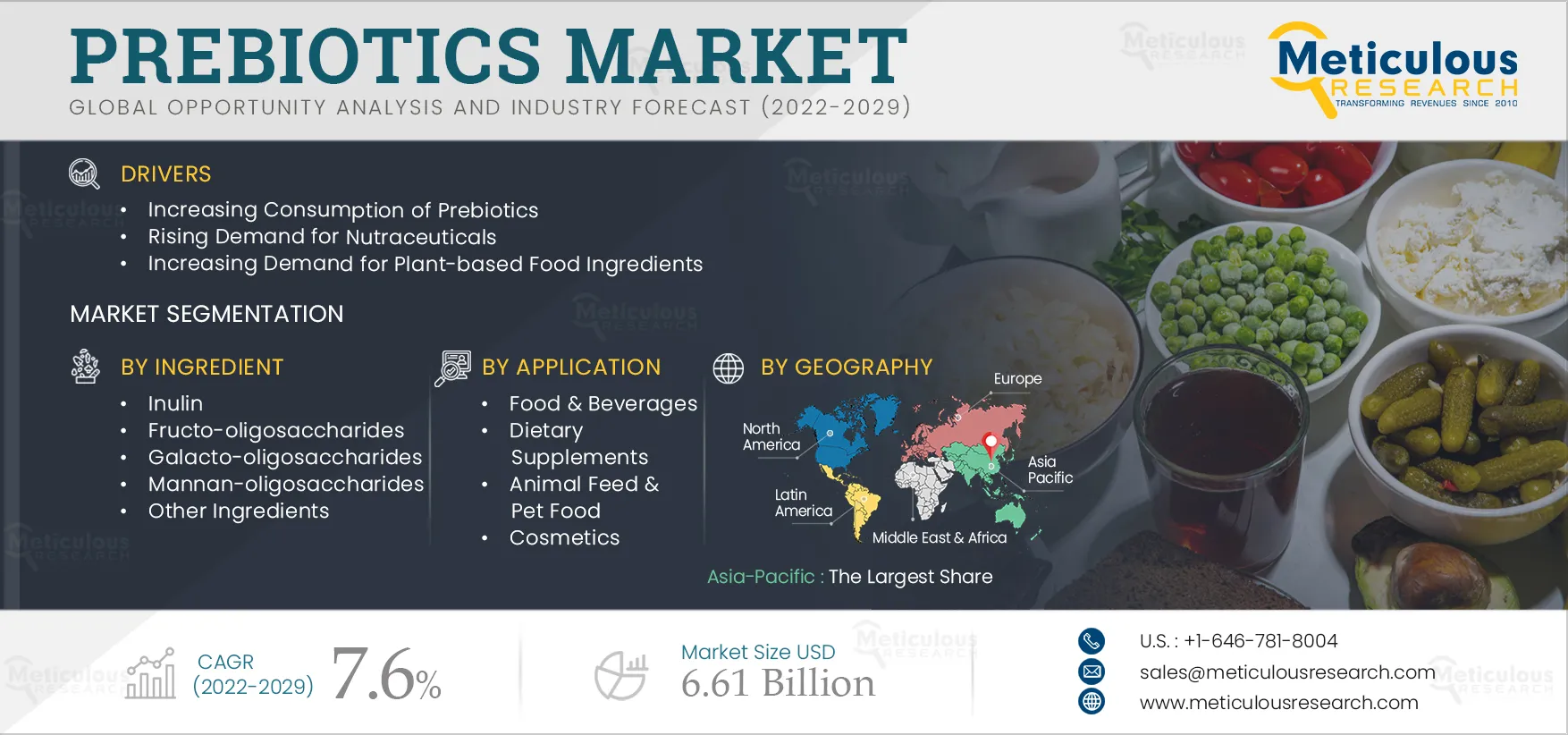The Prebiotics Market is projected to reach $6.61 billion by 2029, at a CAGR of 7.6% during the forecast period 2022–2029. The growth of this market is driven by the increasing consumption of prebiotics, the rising demand for nutraceuticals, and the increasing demand for plant-based food ingredients. However, the lack of awareness regarding the health benefits of prebiotics restrains the growth of this market. The growing use of prebiotics in infant food products is expected to create growth opportunities for the players operating in this market. Additionally, the growing demand for natural, organic, and clean-label ingredients is a major trend in the global prebiotics market.
Here are the top 10 companies operating in the Prebiotics Market
Archer-Daniels-Midland Company (ADM)
Archer-Daniels-Midland Company (ADM) is a global food processing and commodities trading company. The company’s operations are organized, managed, and classified into three reportable business segments: Agricultural Services and Oilseeds, Carbohydrate Solutions, Nutrition, and Others. It offers refined products, starches and sweeteners, vantage corn processors, human nutrition, animal nutrition, industrial biosolutions, probiotics, prebiotics, and postbiotics, and services through these segments. Furthermore, the company also offers fermentation nutrients, solvents, dispersants, biodiesel, industrial oils, fertilizers, emulsifiers & hydrocolloids, ethanol, polyols, propylene glycol, starches, and terpenes. The company offers prebiotic products through the Nutrition segment.
BENEO GmbH (A Part of Sudzucker AG)
BENEO develops and produces plant-based functional ingredients for food, feed, and pharmaceutical products. The company develops functional carbohydrates from sugar beet, prebiotics from chicory root fiber, plant-based proteins, specialty ingredients from rice, feed ingredients, and pharmaceutical excipients. The company offers prebiotic products under its brand Orafti.
Cargill is involved in the manufacturing and marketing of food, agriculture, industrial, and financial services worldwide. The company offers various products & services in the agriculture, food & beverage, beauty, bio-industrial, animal nutrition, industrial, pharmaceutical, meat & poultry, risk management, supplements, and transportation industries. The company offers prebiotic products through the Food & Beverage and Animal Nutrition Product segments.
Ingredion Incorporated
Ingredion is an ingredient solution company. The company operates through three business segments: Food & Beverages, Animal Nutrition, and Others. It offers prebiotic products through the Food & Beverages and Animal Nutrition business segments. The company also offers ingredients such as encapsulants & emulsifiers, extracts, fiber, flours, hydrocolloids, prebiotics, plant-based proteins, starches, and sweeteners and solutions.
International Flavors & Fragrances Inc. (IFF)
IFF is engaged in food, beverage, health, biosciences, and sensory experiences. The company operates through four business segments, namely, Nourish, Health & Biosciences, Scent, and Pharma Solutions. The Nourish business segment is engaged in offering prebiotic products. Furthermore, the company offers animal nutrition, beverage, dietary supplements, food, grain processing, home care, microbial control, perfumery, personal care, and pharmaceutical products.
Kerry Group plc
Ireland, Kerry Group develops, manufactures, and supplies taste and nutritional ingredients for the food, beverage, and pharmaceutical markets. The company operates through two business segments: Taste Nutrition and Consumer Foods, and offers prebiotic products through the Taste Nutrition segment.
The company offers its products to various industries, including dairy, bakery and snacks, beverages, emulsifiers, seasonings, savory, sweet flavors and extracts, food & beverage enzymes, food & beverage plant-based solutions, readymade frozen meals, meat & meat alternative products, proteins, pharmaceuticals, and animal feed, among others.
Roquette Frères is involved in the production and marketing of plant-based ingredients, specialty food ingredients, and pharmaceutical excipients. The company operates through seven business segments: BioPharma, Pharma & Nutraceuticals, Cosmetics, Food & Nutrition, Animal Nutrition, Nutralys Plant Protein, and Industrial Markets. The company offers prebiotic products through the Food & Nutrition and Animal Nutrition segments.
Roquette Frères offers its products to various industries, including beverages, dairy, bakery and snacks, soups, sauces & dressings, confectionery, personal care, animal feed, and industrial.
Royal FrieslandCampina N.V.
FrieslandCampina supplies dairy products, including infant nutrition. The company’s operations are organized, managed, and classified into four reportable business segments: Food & Beverages, Ingredients, Trading, and Specialized Nutrition. The Ingredients segment offers prebiotic products. The company also offers dairy products such as milk, yogurt, condensed milk, dairy-based beverages, cheese, butter, quark, and cream.
Tereos is involved in processing agricultural raw materials such as beet, cane and cereals into sugar, alcohol, and starch and develops food products. The company operates in four business segments, namely, Sugar Europe, Sugar International, Starch and Sweeteners, and Other. Tereos offers alcohol and ethanol, bioethanol, sugar and sweeteners, starch and derivatives, dietary fibers, fibers and germs for animal feed, plant-based proteins, maltodextrins, organic products, and stevia. Furthermore, it offers prebiotic products for human nutrition and animal nutrition.
Yakult Honsha Co., Ltd.
Yakult manufactures and sells food and beverage, cosmetics, pharmaceuticals, fermented milk products, soft drinks, and anticancer drugs, among others. The company operates through three business segments, namely, Food and Beverages, Pharmaceuticals, and Others, of which the Pharmaceuticals and Food and Beverages segments are engaged in offering prebiotic products.
Popular Mention: Jarrow Formulas, Inc. (U.S.), Gobiotics BV (Netherlands), Sensus B.V. (A Part of Royal Cosun) (Netherlands), and Cosucra Groupe Warcoing SA (Belgium).
























